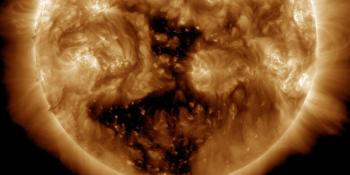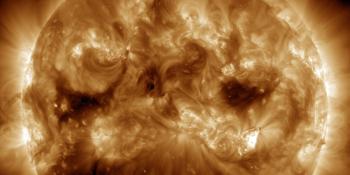Viewing archive of Monday, 8 December 2014
Geophysical report
Any mentioned solar flare in this report has a scaling factor applied by the Space Weather Prediction Center (SWPC). Because of the SWPC scaling factor, solar flares are reported as 42% smaller than for the science quality data. The scaling factor has been removed from our archived solar flare data to reflect the true physical units.
Solar and Geophysical Activity Summary 2014 Dec 08 0245 UTCPrepared by the NOAA © SWPC and processed by SpaceWeatherLive.com
Joint USAF/NOAA Solar and Geophysical Activity Summary
SGAS Number 342 Issued at 0245Z on 08 Dec 2014 This report is compiled from data received at SWO on 07 DecA. Energetic Events
Begin Max End Rgn Loc Xray Op 245MHz 10cm Sweep 0902 0902 0902 150 1018 1018 1018 110 1044 1048 1054 2231 S04E21 C1.0 Sf 160 1106 1106 1106 280 1151 1152 1152 300 1227 1227 1227 110 1333 1333 1333 130 1340 1340 1341 790 2359 2359 2359 350
B. Proton Events
None.
C. Geomagnetic Activity Summary
The geomagnetic field was at quiet
to minor storm levels.
D. Stratwarm
Not available
E. Daily Indices: (real-time preliminary/estimated values)
10 cm 132 SSN 058 Afr/Ap 019/024 X-ray Background B5.6 Daily Proton Fluence (flux accumulation over 24 hrs) GT 1 MeV 1.7e+06 GT 10 MeV 1.1e+04 p/(cm2-ster-day) (GOES-13 satellite synchronous orbit W75 degrees) Daily Electron Fluence GT 2 MeV 3.60e+07 e/(cm2-ster-day) (GOES-13 satellite synchronous orbit W75 degrees) 3 Hour K-indices Boulder 4 2 3 3 5 4 4 2 Planetary 4 2 2 3 5 4 4 3
F. Comments
None.
All times in UTC
Current data suggests there is a slight possibility for aurora to appear at the following high latitude regions in the near future
NuukThe solar wind speed is currently moderately high (634 km/sec.)
The density of the solar wind is moderate (25.56 p/cm3)
The density of the solar wind is moderate (25.56 p/cm3)
Latest news
Latest forum messages
AR4043 9Large Coronal Hole 25 132Aurora photography hints for those of us with smartphones 43Photographing auroras 34More on an art than a science 3
More topicsSupport SpaceWeatherLive.com!
A lot of people come to SpaceWeatherLive to follow the Sun's activity or if there is aurora to be seen, but with more traffic comes higher server costs. Consider a donation if you enjoy SpaceWeatherLive so we can keep the website online!

Latest alerts
00:33 UTC - Radio Blackout
Minor R1 radio blackout in progress (≥M1 - current: M1.71)
Wednesday, 26 March 2025
23:00 UTC - Geomagnetic activity
Minor G1 geomagnetic storm (Kp5) Threshold Reached: 22:37 UTC
20:30 UTC - Geomagnetic activity
Moderate G2 geomagnetic storm (Kp6) Threshold Reached: 20:08 UTC
20:15 UTC - Geomagnetic activity
Minor G1 geomagnetic storm (Kp5) Threshold Reached: 20:00 UTC
18:00 UTC - Geomagnetic activity
Moderate G2 geomagnetic storm (Kp6) Threshold Reached: 17:00 UTC
Space weather facts
| Last X-flare | 2025/02/23 | X2.0 |
| Last M-flare | 2025/03/26 | M1.0 |
| Last geomagnetic storm | 2025/03/22 | Kp6- (G2) |
| Spotless days | |
|---|---|
| Last spotless day | 2022/06/08 |
| Monthly mean Sunspot Number | |
|---|---|
| February 2025 | 154.6 +17.6 |
| March 2025 | 135 -19.6 |
| Last 30 days | 133.8 -19.2 |






